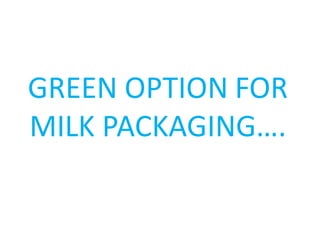
Green Milk Packaging with Hemp and Polypropylene
- 1. GREEN OPTION FOR MILK PACKAGING….
- 2. GREEN OPTIONS FOR MILK PACKAGING • OBJECTIVE: • TO REDUCE THE HARMFULL EFFECTS PRODUCED BY THE PLASTIC COVER IN MANUFACTURING MILK (OR) DIARY PRODUCTS ( i.e., DURING SHIPPING)..
- 3. INTRODUCTION • WHAT IS AN GREEN OPTION? • An ethical way of making choices and preserve the earth’s natural resources and habitats. • Firstly, the alternative is that the usage of glass bottles, metallic tins, bioplastics, paper bottles, bamboo sticks,etc. • Secondly, the cost for the synthesis of polythene covers in large amount is comparatively less for synthesising all the above materials as they are naturally available and also recycled and used again and again…
- 4. 1)Philos Trans R Soc Lond B Biol Sci 2009 BIODEGRADABLE AND COMPOSTABLE ALTERNATIVES TO COVENTIONAL PLASTICS 2) GiuliaCappiello, Clizia Aversa, AnnalisaGenovesi, MassimilianoBarletta 2021 LIFE CYCLE ASSESSMENTOF BIO-BASED PACKAGING SOLUTIONS FOR EXTENDED SHELF LIFE MILK 3)Antonella Cammarelle, Rosaria Visecchia, Franscesco Bimbo 2021 INTENTIONTO PURCHASE MILK PACKAAGED IN IODEGRADABLE PACKAGING 4) Amber Charles Alexis 2022 ECO FRIENDLY FOOD PACKAGING(PLASTIC VS. GREEN ALTERNATIVES) AUTHOR YEAR DESCRIPTION
- 5. EXISTING SYSTEM • All the proposed system related to the green options for milk packaging is purely based on how to degrade the plastic that has been used or how to recycle it. • Alternatively, they have given suggestions on using chemical products, that is based on reducing the cost ( for preservation process)
- 6. DEMONSTRATION OF THE EXISTING SYSTEMS..
- 7. DRAWBACKS OF THE EXISTING SYSTEM *More number of machine or labour work is needed. * More expenses are to be spent on the work they have proposed. *Time consumption is high. *Didn’t give any solution on totally reducing the harmful effects of the plastic covers.
- 8. PROPOSED SYSTEM HEMP PACKAGING: HEMP is an plant which belongs to an botanical class of cannabis sativa It is an already proposed manner where it is processed and is used for packaging solid products where it is an hard product but gets dissolved in liquid (like an cardboard texture)
- 9. COMMON WAY OF PREPARING HEMP
- 10. PROPOSED SYSTEM • POLYPROPELENE PLASTICS: • On comparing the carbon footprint of common plastics, PP has the lowest, that is, 1.95-3 kg of CO2 per kg, compared to 6 kg of CO2 per kg for polyethylene. • It does not have any hazardous disease producing agent on them
- 11. COMMON WAY OF SYNTHESIZING PLASTICS
- 12. MEHODOLOGY • ROTATIONAL MOULDING: • consisting of an mold tool, core side and cavity side. Plastic powder is added and mold in an oven, by heating, mold is slowly related on two axes and thus correct thickness is build. • CRACKING: • Ethane and propane is added and treated with heat in this process to get polymers. (This is to polypropylene plastic).
- 13. THE PROCESS • STEP 1: • FIRSTLY, WE ARE GOING TO TAKE THE HEMP, THAT IS PROCESSED (LIKE CLEANING,GRINDING) ---------> 45%
- 14. THE PROCESS • STEP 2: • NOW, WE COULD TAKE THE POLYPROPELENE PLASTIC (SAFEST PLASTIC) INTO ACCOUNT THAT’S IN MOLTEN FORM • ======> 55% •
- 15. PROPOSED SYSTEM • FINALLY, WE ARE ADDING THOSE TWO ITEMS AND HEATING IN AN TEMPERATURE BETWEEN 158-168K . • THE FINAL LIQUID IS TO POURED INTO THE SHAPER (DESIRED BOTTLE SIZE). • THEY ARE ALLOWED TO COOL DOWN FOR HALF A DAY.
- 16. OUTPUT
- 17. GRAPH SHOWING THE GREEN PACKAGING SYSTEM ACROSS THE WORLD
- 18. CONCLUSION • Flavoured milk packaging is a growing sector which can involve many more innovations but is primarily dominated by aspetic packaging & glass bottle. • Usage of these natural resources in our daily routine may help our society in decreasing the rate of diseases in upcoming days. • To make our society one step ahead using the current technology……
- 19. REFERENCES • The Freedonia Group Inc., August 18,2011. World “Green” packaging demand to reach $212B in 2015. • Terry, L., April 2012. Packaging Goes Green. Inbound Logistics. • Atkinson, W., July 2008. Green Packaging: Waste Not, Want Not. Inbound Logistics.
- 20. Thank You…